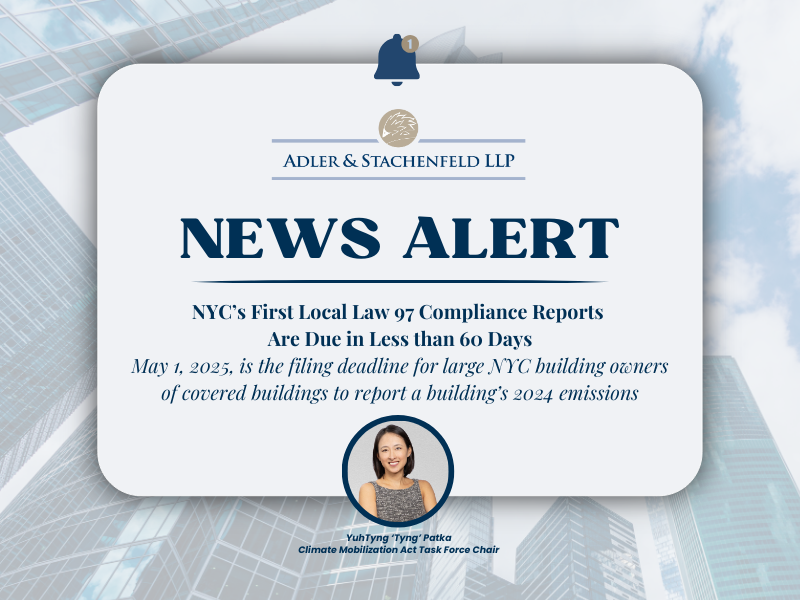Overview
New York City has enacted groundbreaking climate legislation (the Climate Mobilization Act) that will require medium to large-sized privately owned buildings in NYC to reduce greenhouse gas emissions. It puts New York City at the forefront of greenhouse gas reduction emissions.
The goals are ambitious – a 40% reduction of greenhouse gases from (most) buildings in NYC by 2030 and an 80% reduction by 2050. Compliance will need to be in place starting in 2024, petitions for adjustments to compliance measures are due in 2021, and an advisory board, working groups, and other public consultations to implement the law will begin shortly after it goes into effect.
In order to assist owners with the cost of making the necessary green infrastructure to meet these targets, NYC is also implementing PACE (Property Assessed Clean Energy) financing. The PACE program has been enacted in a fair number of U.S. cities, but had not been adopted in New York City until this time, in conjunction with the climate legislation. The reasoning makes sense, in that the PACE financing is a way for owners to finance up to 100% of the cost of the improvement that will be needed to meet the requisite carbon reduction targets.
OVERVIEW OF PACE FINANCING
PACE financing will likely become extremely important in New York City. In brief, PACE financing is a way for owners to finance up to 100% of the cost of the improvements that will be needed to meet the requisite carbon reduction targets. The financing is paid back through tax type assessments on the property which fully amortize over the expected useful life of the improvements that were financed (typically 20–30 years). As PACE payments prime mortgage debt, PACE has been generally resisted by the lending community. However, more and more lenders have been getting comfortable with PACE. With the new legislation, this trend is very likely to continue. Indeed, it is our view that the lenders that permit PACE will have a competitive advantage. At a CREFC After-Work Seminar we recently hosted, City Councilman Costa Constantinides bolstered our view by making the point that PACE was implemented to be an integral part of the Climate Mobilization Act.
HOW CAN OUR FIRM HELP YOU?
We have assembled an NYC Climate Mobilization Task Force to address all client needs in becoming compliant with the new rules. The Task Force consists of a blend of our major practices including:
- Real Estate
- Real Estate Finance
- Leasing
- Development
- Land Use
- NYC Real Estate Tax & Incentives
- PACE Finance
It is too early to say if the energy savings by property owners will offset the capital expenditures needed to comply, but we do know that it will give rise to many issues. Some of the more obvious ones are:
- How will this affect existing buildings?
- How will this affect buildings under construction or major building renovations?
- How will this affect buildings not yet built but which have received permits?
- In joint ventures, how will the cost of compliance be allocated between the parties i.e. if it perhaps causes a cost or operating overrun?
- How will this affect loan balancing or other provisions in construction loan documents?
- For leases – current and future -- is this the landlord’s cost or the tenant’s? Is it passed through?
- Can PACE financing allow for financing of the costs of compliance? And, if so, how does it work?
- Who is responsible for compliance under building and property management agreements, construction loan documents, GMP documents and similar agreements?
- How can affected parties comply with the rules?
- If a building doesn’t comply, what is the penalty and who is liable for it?
- How should parties draft documentation – leases, loan agreements, joint venture documents, management agreements, development agreements and other documents -- to properly delineate their respective obligations going forward?
- How should one go about making a case that alternative compliance measures are not necessary and appropriate? The statute mentions a “reasonable financial return” – how would that be determined?
- The law provides for the adoption of regulations. When will that be? What are they likely to say? How can building owners participate in the formulation of guidance and regulations?
STRATEGIC RELATIONSHIPS
Additionally, our Task Force has created strategic relationships with consultants, engineers, and similar parties that will help navigate our clients through all parts of compliance with the new legislation.
We anticipate that the Climate Mobilization Act and PACE will have a major impact on our clients in the New York City real estate industry. We are committed to assisting our clients as a resource. In addition to our help as real estate lawyers, this will include referring our clients to consultants or third parties that might have the expertise we do not.
READING MATERIALS
- Less than 60 Days Until NYC’s First Local Law 97 Compliance Reports are Due (March 2025)
- Are NYC building owners ready for Local Law 97 (September 2023)
- Carbon Emission Regulations for NYC Buildings Released | Owners Advised to Take Note of Costs and Other Issues 9 (October 2022)
- Major Costs and Obligations of the Climate Mobilization Act in NYC Ticks Closer (January 2021)
- COVID-19 Does Not Give Relief from NYC's Climate Mobilization Act (June 2020)
- Quick Q&A on The Climate Mobilization Act
- Just Say No to Carbon Emissions – What NYC Building Owners and Developers Need To Know About the Climate Mobilization Act
- COVID-19’s Effect on Local Law 97 – or lack thereof (Lexis Practice Advisor)
- How NYC is Picking up the 'PACE' (New York Law Journal)
- Understanding the Requirements of the Climate Mobilization Act (Lexis Practice Advisor)




